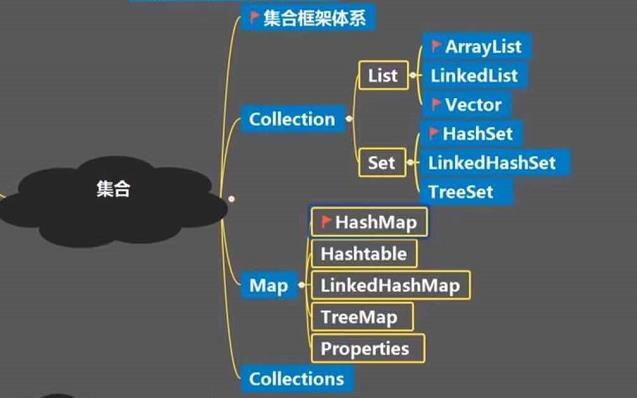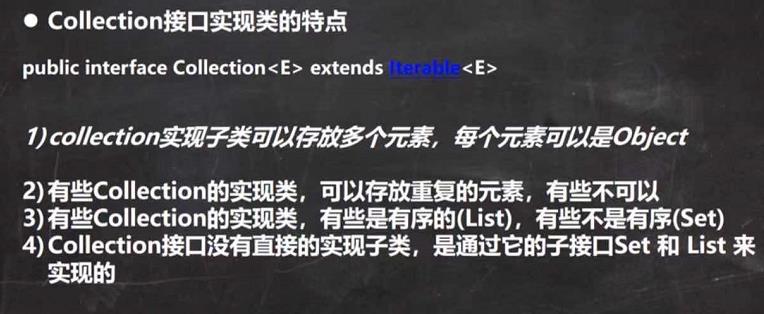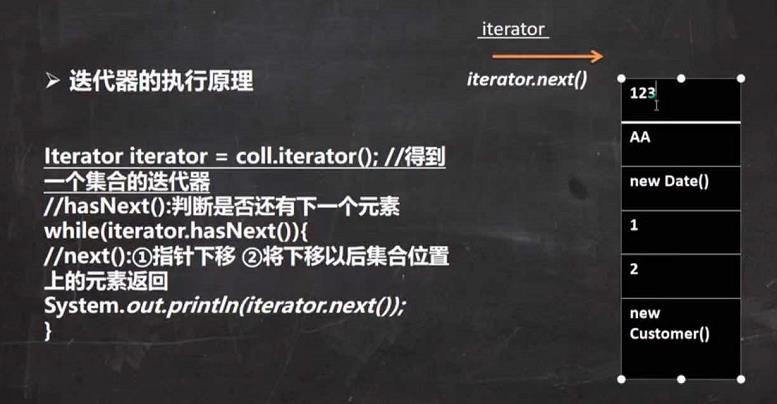Java集合
Posted Wecccccccc
tags:
篇首语:本文由小常识网(cha138.com)小编为大家整理,主要介绍了Java集合相关的知识,希望对你有一定的参考价值。
集合

集合的理解和好处


集合的框架体系
1.集合主要是两组(单列集合,双列集合)
2.Collection 接口有两个重要的子接口 List Set,他们的实现子类都是单列集合
3.Map 接口的实现子类 是双列集合,存放的K-V


Collection接口和常用方法


01:
package HomeWorkD01;
import java.util.ArrayList;
import java.util.List;
public class CollectionDemo {
@SuppressWarnings("all")
public static void main(String[] args) {
List list = new ArrayList();
list.add("jack");
list.add(10);
list.add(true);
System.out.println(list);
list.remove(new Integer(10));
System.out.println(list);
list.remove("jack");
System.out.println(list);
System.out.println(list.contains("jack"));
System.out.println(list.size());
System.out.println(list.isEmpty());
list.clear();
System.out.println(list);
List list2 = new ArrayList();
list2.add("jack");
list2.add("three countries");
list.addAll(list2);
System.out.println(list);
System.out.println(list.containsAll(list2));
list.removeAll(list2);
System.out.println(list);
}
}
Collection接口遍历元素方式1-iterator(迭代器)



01:
快捷键:itit
all快捷键 ctrl+j
package HomeWorkD01;
import java.util.ArrayList;
import java.util.Collection;
import java.util.Iterator;
public class CollectionIterator {
@SuppressWarnings("all")
public static void main(String[] args) {
Collection col = new ArrayList();
col.add(new Book("three countries","luoguanzhon",10.1));
col.add(new Book("fly knife of li","old long",5.1));
col.add(new Book("red city dream","chaoxuex",34.6));
System.out.println(col);
Iterator iterator = col.iterator();
while(iterator.hasNext())
{
Object next = iterator.next();
System.out.println(next);
}
//itit
// while (iterator.hasNext()) {
// Object next = iterator.next();
//
// }
//重置
iterator = col.iterator();
while(iterator.hasNext())
{
Object next = iterator.next();
System.out.println(next);
}
}
}
class Book
{
private String name;
private String author;
private double price;
public String getName() {
return name;
}
public void setName(String name) {
this.name = name;
}
public String getAuthor() {
return author;
}
public void setAuthor(String author) {
this.author = author;
}
public double getPrice() {
return price;
}
public void setPrice(double price) {
this.price = price;
}
public Book(String name, String author, double price) {
this.name = name;
this.author = author;
this.price = price;
}
@Override
public String toString() {
return "Book{" +
"name='" + name + '\\'' +
", author='" + author + '\\'' +
", price=" + price +
'}';
}
}
Collection接口遍历元素方式2-增强for循环

01:
快捷方式 col.for
package HomeWorkD01;
import java.util.ArrayList;
import java.util.Collection;
import java.util.Iterator;
public class CollectionIterator {
@SuppressWarnings("all")
public static void main(String[] args) {
Collection col = new ArrayList();
col.add(new Book("three countries","luoguanzhon",10.1));
col.add(new Book("fly knife of li","old long",5.1));
col.add(new Book("red city dream","chaoxuex",34.6));
//底层还是迭代器
for (Object book : col)
{
System.out.println(book);
}
//也可以在数组使用
int[] nums = {1,2,345,634};
for (int i:nums)
{
System.out.println(i);
}
//col.for 快捷方式
// for (Object o : col) {
//
// }
}
}
class Book
{
private String name;
private String author;
private double price;
public String getName() {
return name;
}
public void setName(String name) {
this.name = name;
}
public String getAuthor() {
return author;
}
public void setAuthor(String author) {
this.author = author;
}
public double getPrice() {
return price;
}
public void setPrice(double price) {
this.price = price;
}
public Book(String name, String author, double price) {
this.name = name;
this.author = author;
this.price = price;
}
@Override
public String toString() {
return "Book{" +
"name='" + name + '\\'' +
", author='" + author + '\\'' +
", price=" + price +
'}';
}
}
小练习

01:
package HomeWorkD01;
import java.util.ArrayList;
import java.util.Iterator;
import java.util.List;
public class CollectionArrayListHomeWork01
{
@SuppressWarnings("all")
public static void main(String[] args) {
List list = new ArrayList();
list.add(new Dog("small black",3));
list.add(new Dog("big yellow",100));
list.add(new Dog("big strong",8));
for (Object dog : list) {
System.out.println(dog);
}
Iterator iterator = list.iterator();
while (iterator.hasNext()) {
Object dog = iterator.next();
System.out.println(dog);
}
}
}
class Dog
{
private String name;
private int age;
public Dog(String name, int age) {
this.name = name;
this.age = age;
}
public String getName() {
return name;
}
public void setName(String name) {
this.name = name;
}
public int getAge() {
return age;
}
public void setAge(int age) {
this.age = age;
}
@Override
public String toString() {
return "Dog{" +
"name='" + name + '\\'' +
", age=" + age +
'}';
}
}
List接口方法和常用方法


01:
package HomeWorkD01;
import java.util.ArrayList;
import java.util.List;
public class ListDemo01 {
@SuppressWarnings("all")
public static void main(String[] args) {
List list = new ArrayList();
list.add("tom");
list.add("tom");
list.add("jack");
list.add("bigstrong");
//1.list集合类中元素有序
System.out.println(list);
//2 and 3.list集合中的每个元素都有其对应的顺序索引,即支持索引
//索引从0开始
System.out.println(list.get(3));
//3.
}
}
02:
package HomeWorkD01;
import java.util.ArrayList;
import java.util.List;
public class ListMethod {
@SuppressWarnings("all")
public static void main(String[] args) {
List list = new ArrayList();
list.add("zsf");
list.add("jby");
//在index 位置插入ele元素
//void add(int index,Object ele)
list.add(1,"hsp");//如果前面没加数字,默认加在最后
System.out.println(list);
//boolean addAll(int index,Collection eles)
//从index位置开始将eles中的所有元素添加进来
List list2 = new ArrayList();
list2.add("jack");
list2.add("tom");
list.addAll(1,list2);
//Object get(int index)
//获取指定index位置的元素
//int indexOf(Object obj)
//返回obj在集合中首次出现的位置
System.out.println(list.indexOf("tom"));
//int lastIndexOf(Object obj)
//返回obj在当前集合中末次出现的位置
System.out.println(list.lastIndexOf("bigstrong"));
//Object remove(int index)
//移除指定index位置的元素,并返回此元素
list.remove(0);
System.out.println(list);
//Object set(int index,Object ele)
//设置指定index位置的元素为ele,相当于是替换
list.set(1,"mali");
//List subList(int fromIndex,int toIndex)
//返回从fromIndex到toIndex位置的子集合 前闭后开
//fromIndex <= subList < toIndex
List list1 = list.subList(0,2);
System.out.println(list1);
}
}

01:
package HomeWorkD01;
import java.util.ArrayList;
import java.util.Iterator;
import java.util.List;
public class ListExercise {
@SuppressWarnings("all")
public static void main(String[] args) {
List list = new ArrayList();
for (int i= 0;i<12;i++)
{
list.add("hello"+i);
}
System.out.println(list);
list.add(1,"hspedu");
System.out.println(list);
System.out.println(list.get(4));
list.remove(5);
System.out.println(list);
list.set(6以上是关于Java集合的主要内容,如果未能解决你的问题,请参考以下文章